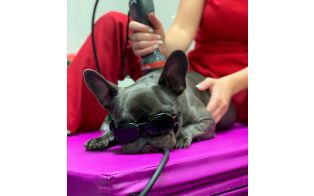New Laser Application Techniques to the Canine Joint
1 hour
Eligible Online
Optimizing Your Laser Therapy Application Technique: Canine Joints
Mastering laser therapy for canine joints requires proper patient evaluation, positioning, dosage, technique, and session frequency. Through illustrations and videos, this course will guide you in applying laser therapy to the entire spine and joints of the thoracic and pelvic limbs, covering key techniques and equipment use for optimal results.
Details
The goal of applying laser therapy to any canine joint structure is to obtain a consistent and repeatable clinical result. Sara Granberg, DVM, CCRP, and Lauren Bueter, BS, RVT, CCRP, both owners of Michiana Animal Rehab Services, have utilized laser therapy in the treatment of their patients over many years. During this time, they have used several therapeutic lasers and learned to optimize different application techniques to achieve optimal results.
The first part of the course reviews the fundamental information required when using laser therapy: laser safety, patient evaluation, the difference between application techniques such as selecting an appropriate handpiece, administering on or off contact using a scanning or point-to-point technique, proper dosing considerations, and the frequency of administration.
Starting with the cervical, thoracic, and lumbar spine and then continuing with all of the joints of both the thoracic and pelvic limbs, the attendee will understand the importance of a diagnosis, appreciate how the anatomy surrounding these structures influences the ability of light to saturate all of the joint structures, be able to properly position the patient while being respectful of their comfort, know the benefits of different application techniques, how to treat all of the primary and compensatory anatomical structures, and the frequency of the therapy sessions to optimize results.
Each canine joint structure will be explained using medical illustrations and then demonstrated, using short videos, various application techniques. Different therapeutic laser equipment, including different handpieces, will be used on each anatomical area, so regardless of the laser equipment in your practice, the attendee will gain insight into maximizing its use.
The final portion of this course highlights the contraindications and false contraindications that should be considered when utilizing laser therapy. There is even a short video on how not to apply laser therapy to your patients.
Purchase 2 or more at once and save $25 per course! Just add to your cart and the discount will be applied automatically.
More Information
| Course Length | 1 hour |
|---|---|
| Learning Objectives | Upon completion of this course you will understand:
|
| Additional Recommended Courses | none |
| Agenda | Fundamental Information
Optimizing the Application of LT to Each Canine Joint Structure
Contraindications False Contraindications Summary Course Evaluation Certificate of Completion |
| Certifications | This program has been approved for 1.0 hour of continuing education credit in jurisdictions which recognize AAVSB RACE approval; however participants should be aware that some boards have limitations on the number of hours accepted in certain categories and/or restrictions on certain methods of delivery of continuing education. |
| Platform | Eligible, Online |

